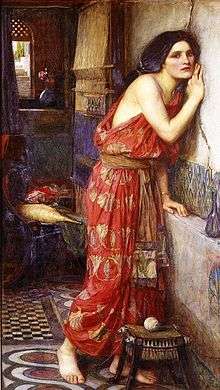Pyramus and Thisbe Club
The Pyramus and Thisbe Club is a UK based non-profit organization. It was founded in 1974 by a group of party wall surveyors. It helped draft the Party Wall etc. Act 1996 and continues to educate its members and the public about party wall issues.
History

The Pyramus and Thisbe Club was founded in 1974 at the instigation of the late John Anstey, following widespread misreporting of the case of Gyle-Thompson v Wall Street (1973). The Club was formed to exchange news and opinions about interesting party wall cases. Its first Chairman was Alan Gillett. The original membership of 46 active party wall surveyors agreed to meet quarterly and these early meetings took place at the Little Ship Club in the City of London. Membership grew but was then limited to 100 and the Club moved its meetings to The Cafe Royal in Regent Street.
The club takes its name from Ovid's Pyramus and Thisbe, lovers kept apart by their rival parents, but who whispered through a chink in a wall. The story has been retold by many including Shakespeare in A Midsummer Night's Dream. The Club's motto, a quotation from the play, is "The wall is down that parted their fathers." The Club's quarterly newsletter is called Whispers.
Until 1997, the Club's activities were confined to inner London, where the London Building Acts (Amendment) Act 1939 applied only to party walls in the former LCC area. In 1993 a Club working party began drafting a Parliamentary Private Bill for England and Wales. The Bill which was sponsored through Parliament by The Earl of Lytton (now a past chairman of the Club) received Government support and became the Party Wall etc. Act 1996. It came into force in July 1997.
The Club's pivotal role in framing the Act was acknowledged by The Earl of Kinnoull during the debate following the Bill's second reading in the House of Lords, when he said of the Club, "I know that that club of professionals has done tremendous work. I pay particular tribute to its chairman, John Anstey, who, like other colleagues has been active in helping to draft the Bill." The Pyramus and Thisbe Club continues to maintain relationships with Government and Parliament. Members of the Club have formed advisory panels to consider the Subterranean Development Bill and the Property Boundaries (Resolution of Disputes) Bill. The Club has assisted the Government in producing a guide to the Act and Club members have advised overseas governments on party wall and neighbourly matters.
In a 2008 case in Romford County Court, His Honour Judge Platt acknowledged the Club's members when he said, "It is a tribute to the surveyor's profession as a whole and to the members of the Pyramus and Thisbe Club in particular that issues over party walls have generally been resolved by a pragmatic and cooperative approach to the provisions of the Act and consequently appeals to the County Court have been extremely rare."
The Club's membership is drawn from a mixture of surveyors, architects, engineers, other construction professionals and lawyers, all of whom have an interest in party wall matters. Today there are some 1000 members practising throughout England and Wales. The only qualification for membership is a serious professional interest in the subject and a willingness to disseminate information among fellow members about difficult or interesting cases.
The Club is a non profit-making organisation and has acquired the status of a Learned Society. It promotes the highest standards of professional conduct among its members. The Club has published a two volume "Collected Papers" from the first 20 years of its proceedings and "The Party Wall Act Explained" written by the members of the original working party, now in its second, revised edition.